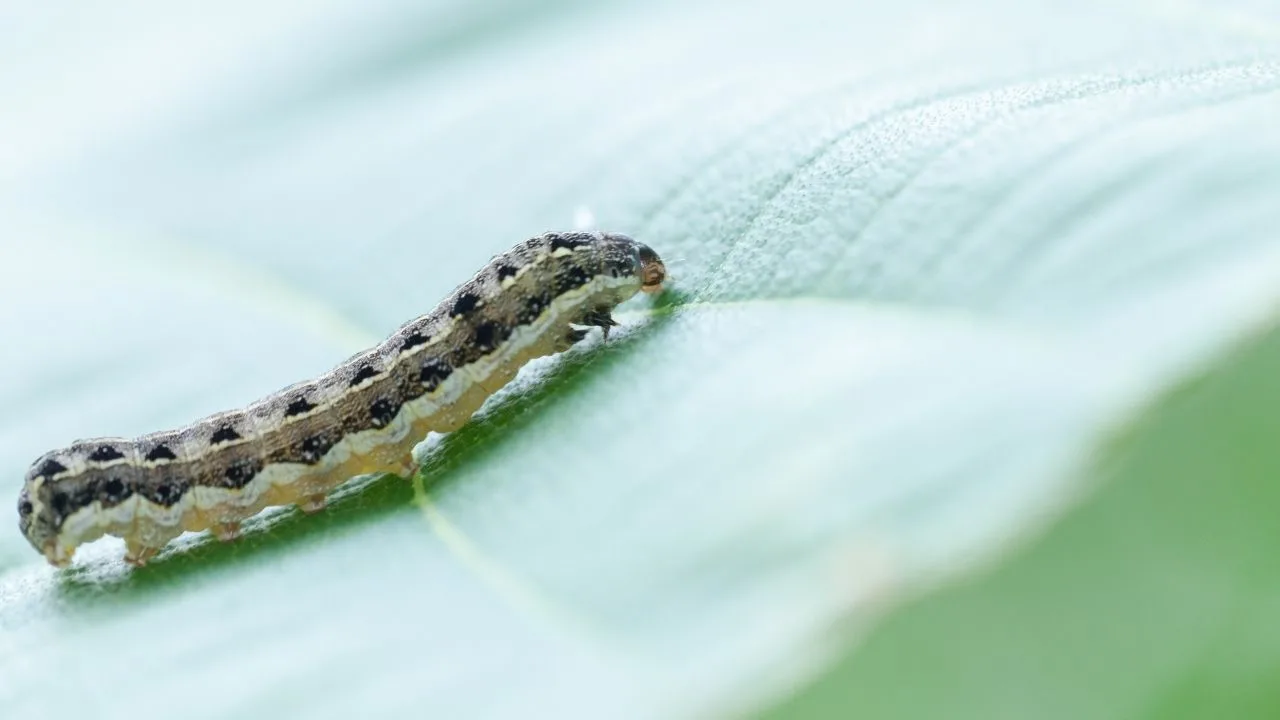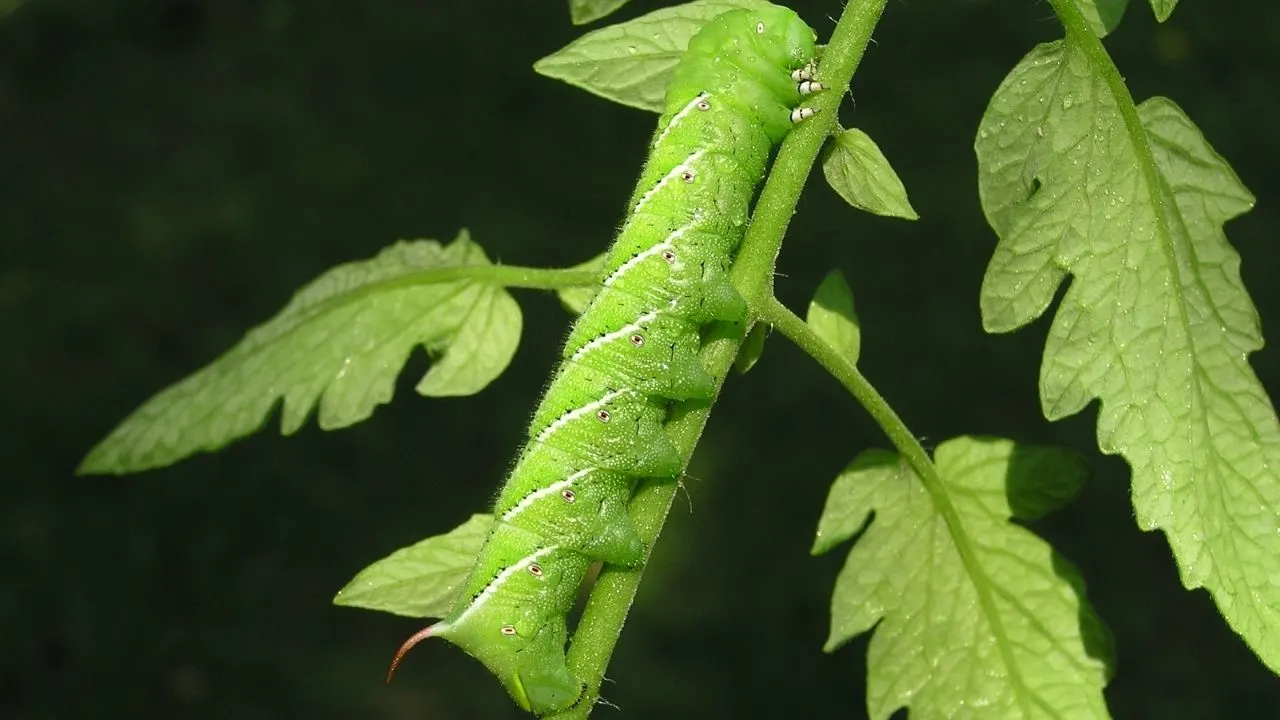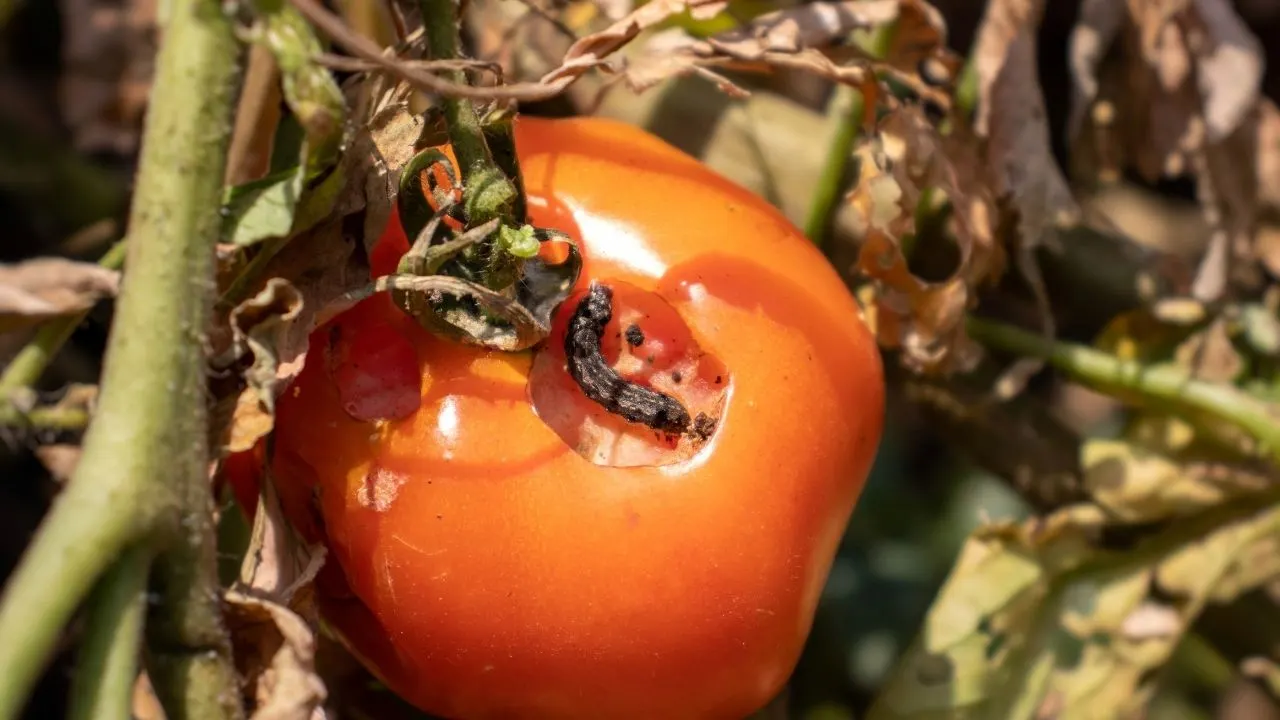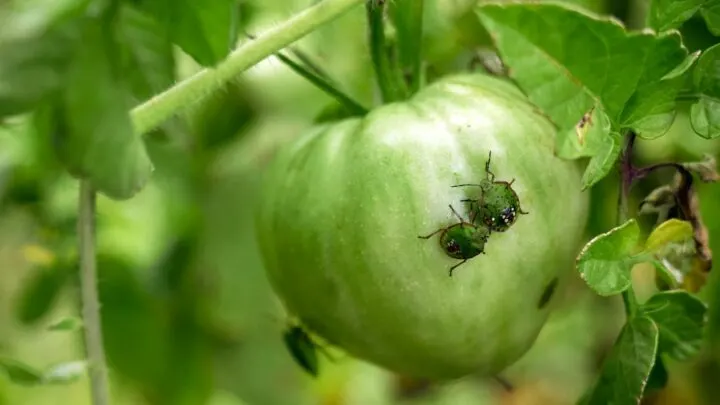There’s nothing worse than walking outside one morning and discovering your once beautiful and healthy crop of tomatoes or brand new seedlings are now destroyed due to a nasty insect infestation.
Whether it’s hornworms, whiteflies, cutworms, or another destructive pest, insects can wreak havoc on your tomato crop and can decimate plants, sometimes seemingly overnight.
So, what’s the solution? Keeping bugs off tomatoes can be simple, as long as you know what to do.
Table of Contents
How to Keep Bugs Off a Tomato Plant
To prevent pests from devouring your tomatoes, look for chewed-up leaves, stems, or fruit. The best general prevention method is spraying leaves with properly diluted soapy water. Mix one or two tablespoons of mild dish soap with a gallon of water, and spray leaves once a week and after it rains.
How to Use Soapy Water as Bug Repellant
The first step to preventing an insect infestation is to be vigilant and pay close attention to the plant’s general vigor and leaves to ensure they’re healthy and not chewed up, yellow, or curling upwards.
One of the best tried-and-true methods for pest control is spraying soapy water to deter insects.
However, the soapy mixture must be diluted correctly, or it can damage the plant itself. This method also works as a fungicide and can help tomatoes resist other diseases too.
Mix a gallon of water with 1-2 tablespoons of a mild soap dish, and squirt it on the plants once a week or after it rains.
Only use mild dish soap because laundry soap and chemical dish detergents are too strong and will damage the tomato plants.
Test the Mixture First
Before you douse every plant with your mixture, perform a quick test to ensure it’s properly diluted.
Spray a couple of leaves and wait about 48-72 hours. If the leaves still look healthy, you’re good to go.
If they’re spotted or discolored brown, you have the wrong concentration or the wrong kind of soap.
While a light soapy water spray is an excellent general prevention method, an existing infestation may require some insect-specific techniques.
If an existing infestation is left unchecked, the insects will quickly reduce vigor and inhibit new growth and fruit production, eventually causing premature plant death.
Natural Methods of Repelling Insects
When it comes to protecting tomato plants from insects, there are many different effective techniques to use, including insecticides.
However, you shouldn’t resort to using chemical means straight away.
In fact, broad-spectrum insecticides can harm beneficial insects and pollinators that are essential to keep your garden and plants thriving.
Plant Trap Crops
One natural method to get rid of pests is by planting trap crops in your garden. You can even try planting a few sacrificial tomato plants so the real ones don’t get eaten.
The primary purpose of trap crops is to take the brunt of any insect damage that otherwise would ruin your tomato crop.
Planting should occur about eight or twelve feet away from your “real” harvest.
What are the best trap crops for insects?
Here’s a brief list of these trap crops:
- Plant dill to attract tomato hornworms
- Radishes work best for flea beetles
- Eggplant is suitable for potato bugs
- Nasturtiums or okra will attract aphids
- Marigolds for root-knot nematodes
Tomatoes are vulnerable to all the insects listed above, which can devastate a crop and significantly affect yield.
However, they’re particularly susceptible to cutworms, tomato hornworms, and tomato fruitworms.
Cutworms

The cutworm may be small, but the damage it can cause is very large, indeed.
These pests can kill an entire garden’s worth of seedlings overnight by gnawing through the stem underneath the soil. They’re about an inch long and curl up defensively into a C when threatened.
To prevent cutworm damage, all you need is a cardboard toilet paper roll.
Cut the tube to about three inches long, then place it around the base of the tomato with about half the tube stuck into the soil.
The cutworms won’t climb over the collar, keeping your plants safe.
You can also spread cornmeal around the base of the plants, which cutworms absolutely love but can’t digest, so it kills them once they start eating it.
Tomato Hornworms

The tomato hornworm is one of the most common pests you’ll find munching on a tomato plant.
They’re big, bright green, and have a tiny little horn that sticks out above their head.
They’re also incredibly destructive to tomato plants and can quickly defoliate leaves. They’ll munch on the growing tomatoes, too.
Look for spotted, chewed-up leaves with black or dark green droppings on them.
The best way to deter hornworms is the “pick and squish” method.
However, if you find tiny white egg sacks on the hornworm’s back, better leave it. Those egg sacs are from a parasitic wasp.
The wasp larvae hatch and eat the hornworm from the inside out.
By leaving the wasp eggs to hatch successfully, you can help prevent further hornworm infestations, as the wasp is their natural predator.
Tomato Fruitworms

Tomato fruitworms will destroy your big, plump tomatoes from the inside out.
Once the worms hatch, they burrow into the tomato and then devour it from the inside. They will also eat the stems and leaves, so they can quickly decimate and deflower a plant.
Be vigilant for larvae or eggs, which are white at first and turn brown right before hatching.
You can also apply neem oil or insecticidal soap about once a week.
If you have corn or peppers, keep them far away from your tomato plants because they’re both common host plants for fruitworms.
Keep Your Tomato Plants Pest-Free
There are many specific ways to deal with an insect infestation on your tomato plants once they’re already munching away.
However, the best general prevention method is to spray your crop once a week and after it rains with a mixture of mild dish soap mixed with water, about one or two tablespoons per gallon of water.
You can also try planting trap crops or some sacrificial tomatoes to keep insects off the actual harvest.
Pay close attention to your plants to catch infestations before they become severe, and you’ll end up with a beautiful crop of fat, healthy, and bright red tomatoes.

Daniel has been a plant enthusiast for over 20 years. He owns hundreds of houseplants and prepares for the chili growing seasons yearly with great anticipation. His favorite plants are plant species in the Araceae family, such as Monstera, Philodendron, and Anthurium. He also loves gardening and is growing hot peppers, tomatoes, and many more vegetables.


